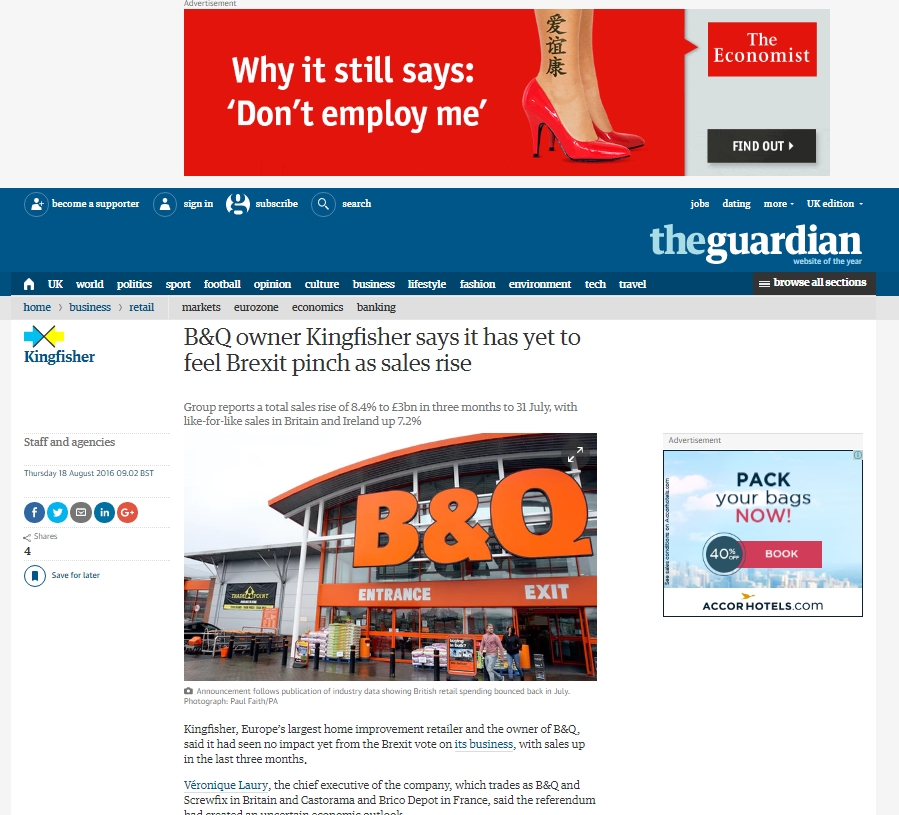
The Guardian is running its first digital ad campaign based on the amount of time people see the ads.
Advertisers can now buy ads across the Guardian’s properties in guaranteed time slots of 10-, 15-, 20- or 30-second fragments, 100 percent in view. The Economist is the first client to buy the Guardian’s ads in this way and will be running a campaign until September.
“It’s part of our fewer, better ads strategy, and it develops our thinking that not all ad impressions are the same,” said Nick Hewat, commercial director at the Guardian. “This isn’t a one-off problem solver; it’s part of an ongoing objective to deliver more tangible results for our clients.”
The Guardian joins the Financial Times and the Economist in billing ads by time. The thinking goes that buying ads based on number of impressions doesn’t translate to an effective campaign and can lead to clients paying for ads that are never seen. The interest from publishers is growing as they try to find an alternative way to charge for ads when they deliver value. Time is an alternative way of gauging whether the ad caught the reader’s attention.
Both the FT and the Economist have found, unsurprisingly, that ads perform better when people spend more engaged time with them. While it’s too soon to tell for the Guardian, Hewat is confident this method will provide added value for its clients.
“We use click-through rate as an industry benchmark for performance;. However a metric of 0.0 something percent should not be seen as a success; it’s not an indicator of long-term success, of brand health and attention,” Hewat added, saying other advertisers are interested in running campaigns in this way, although he was unwilling to name any.

The ads running on the Guardian is part of the Economist’s “raising eyebrows and subscriptions” campaign which has been live since 2014, picking up multiple accolades for its effectiveness along the way. By June this year the campaign had generated 5.2 million clicks and 64,000 new subscribers worth £51.7 million ($67.9 million) in revenue.
During this time, the Economist has developed a test matrix for media buying with clearly defined sets of performance benchmarks. It has tested buying ads based on viewability, click-through rate and impressions in a bid to get the most of out of its media dollars. If a campaign bought on viewability beats the benchmarks, then it will switch up spend.
“We’re lighting lots of small fires to see where we’ll get the big flames,” said Mark Beard, svp of digital media and content strategy at the Economist. “We need to be buying on engagement, and buying on time is a useful test because time is a potential proxy for engagement.”
“Marketers do their best work when they align the objectives of the campaign with the media buy. Then you are buying media on the same basis as the campaign deliverable,” Beard added. People don’t buy luxury handbags by clicking on an ad, for instance. “More publishers will do it if there’s demand for it and they can see that people want to buy in this way.”
Still, selling ads based on time may sound good, convincing more advertisers to move beyond clicks and impressions remains a struggle. “There may be an education job publishers need to do, too. If time-based buying is a more efficient way for brands to spend their money, then that message is going to have to be distributed. There is an onus on marketers to be cutting edge.”
More in Media

Here are the biggest moments in AI for publishers in 2025
Here are some of the moments that defined how publishers adapted to the AI era this year.

Digiday+ Research roundup: Gen Z news consumption and diversification in the DSP space were 2025’s top trends
As 2025 winds down, we rounded up the biggest trends of the year, based on the data that resonated the most with Digiday’s readers.

What publishers are wishing for this holiday season: End AI scraping and determine AI-powered audience value
Publishers want a fair, structured, regulated AI environment and they also want to define what the next decade of audience metrics looks like.





